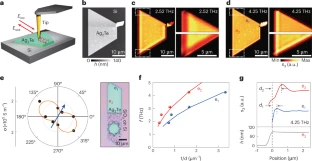Phys.org May 4, 2023
Thin layers of in-plane anisotropic materials can support ultra confined polaritons, whose wavelengths depend on the propagation direction. Such polaritons hold potential for the exploration of fundamental material properties and the development of novel nanophotonic devices. However, the real-space observation of ultra confined in-plane anisotropic plasmon polaritons (PPs)—which exist in much broader spectral ranges than phonon polaritons—has been elusive. An international team of researchers (Spain, China, Czech Republic, UK, Germany) imaged and analyzed THz waves that propagate in the form of plasmon polaritons along thin anisotropic semiconductor platelets with wavelengths reduced by up to 65 times compared to THz waves in free space. The hybridization of the PPs with their mirror image—by placing the platelets above an Au layer—increased the direction-dependent relative polariton propagation length and the directional polariton confinement. This allowed for verifying a linear dispersion and elliptical isofrequency contour in momentum space, revealing in-plane anisotropic acoustic terahertz PPs. According to the researchers their work shows that THz waves can be applied for probing fundamental material properties at the nanometer scale and pave the way to the development of ultra-compact on-chip THz devices… read more. TECHNICAL ARTICLE

Real-space nanoimaging of in-plane anisotropic THz PPs on Ag2Te platelets. Credit: Nature Materials (2023)